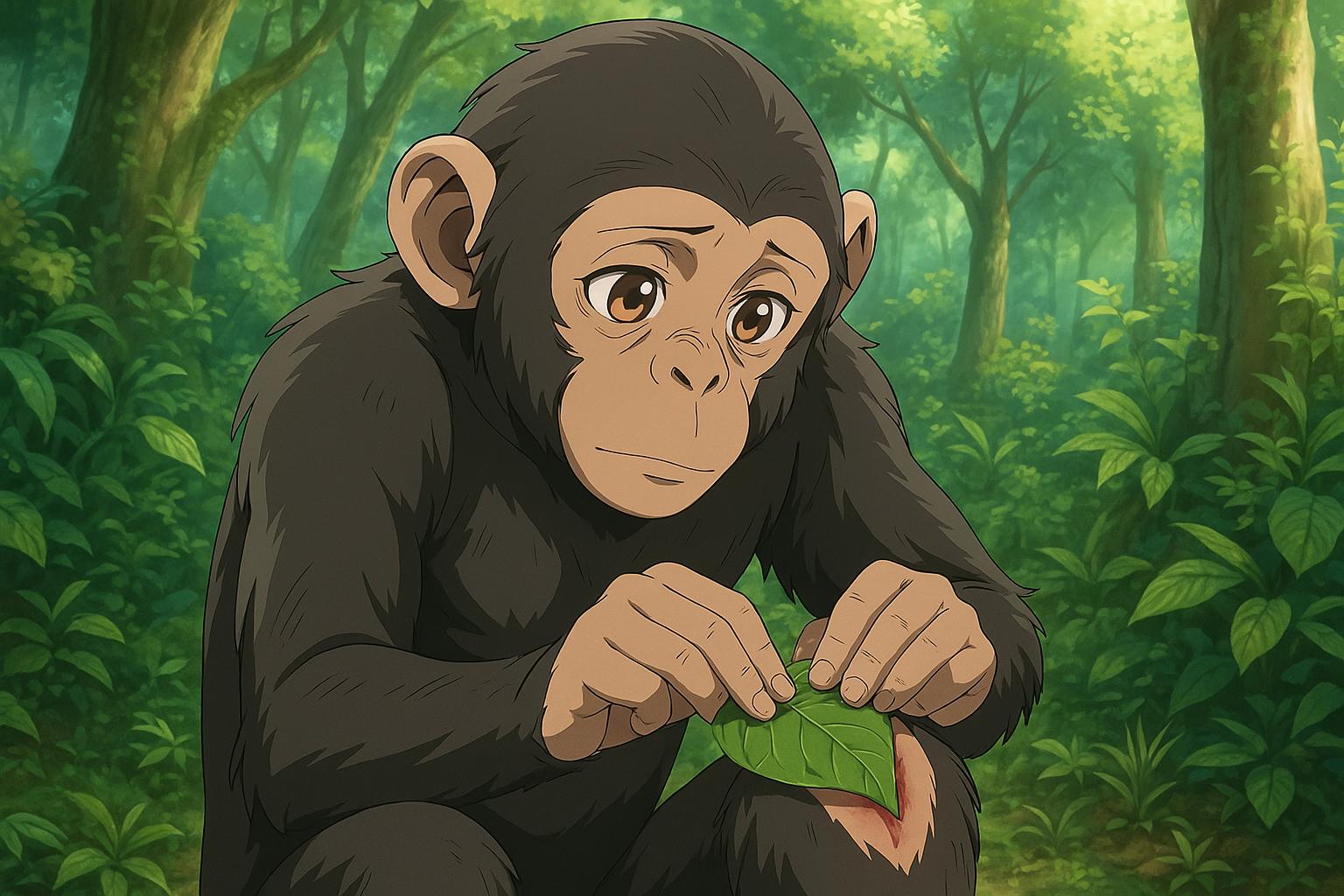New research in Uganda’s Budongo Forest reveals wild chimpanzees applying medicinal plants to heal injuries, including acts of care towards others, highlighting their cognitive skills and offering insights into the evolutionary roots of medicine.
Chimpanzees in Uganda have recently been filmed demonstrating an impressive array of self-medication behaviours, employing medicinal plants to treat injuries in both themselves and others. This breakthrough comes from researchers at the University of Oxford, who conducted an extensive study in the Budongo Forest, a region rich in biodiversity and natural resources. Their findings, published in the journal Frontiers in Ecology and Evolution, reveal a complex behavioural repertoire that underlines the cognitive and empathetic abilities of these primates.
The researchers observed chimpanzees using various plants to address open wounds, utilising methods such as dabbing plant material directly on injuries or chewing specific leaves before applying them as poultices. Notably, instances were recorded of a juvenile female chimpanzee tending to a wound on her mother, suggesting not just self-care but a capacity for empathy—a quality that has been a topic of much debate among primatologists. Lead researcher Elodie Freymann highlighted this behaviour as particularly significant, stating, “It adds to the evidence that wild chimpanzees have the capacity for empathy.”
This study builds on previous research that identified certain plants as having medicinal properties, correlating their use with antibacterial effects. For instance, chemical analyses revealed that the dead wood from the Alstonia boonei tree exhibits strong antibacterial activity, reinforcing its potential role in wound treatment. In total, the study catalogued several plants with anti-inflammatory and antibiotic properties, drawing upon decades of observations recorded in a field log book by researchers and local staff since the 1990s. Anecdotes in this log contain fascinating accounts of chimps engaging in rituals remarkably akin to hygiene practices seen in humans, such as using leaves to clean themselves after defecating.
Moreover, this wealth of information sheds light on the broader implications of animal self-medication, a field known as zoopharmacognosy. This discipline focuses on how various species select and use natural substances to treat ailments, bringing new perspectives on the origins of human medicinal practices. It has been shown, for example, that orangutans also exhibit similar self-medication behaviours. An adult male was recently observed using a specific plant to treat a facial wound, marking the first documented instance of such direct application of a medicinal remedy in wild animals. Such behaviours underscore the evolutionary roots of self-care practices that may extend back to a common ancestor shared with humans.
The research not only accentuates the importance of preserving the habitats of these primates but also raises the potential for discovering new medicines from the same plants they utilise. Given that 88% of the plant extracts tested in one study inhibited bacterial growth, and 33% exhibited anti-inflammatory effects, the therapeutic prospects are considerable. The evidence consistently points to a sophisticated understanding of their environment by chimpanzees, suggesting an innate ability to identify and utilise the healing properties of their ecosystem.
As scientists continue to uncover the layers of these complex interactions between wildlife and natural medicine, it becomes clear that protecting these “forest pharmacies” is crucial—not just for the species that inhabit them, but potentially for human health as well, as we seek new avenues for medicinal discoveries rooted in nature’s wisdom.
Reference Map
- Paragraphs 1, 2, 3, 4
- Paragraphs 1, 3, 4
- Paragraphs 3, 4
- Paragraphs 2, 4
- Not used
- Not used
- Not used
Source: Noah Wire Services
- https://www.bbc.com/news/articles/cqj7ln85vxwo – Please view link – unable to able to access data
- https://www.ox.ac.uk/news/2024-06-21-study-shows-wild-chimpanzees-seek-out-medicinal-plants-treat-illness-and-injuries – A study led by the University of Oxford found that wild chimpanzees in Uganda actively seek out medicinal plants to treat illnesses and injuries. Researchers observed 51 chimpanzees in the Budongo Central Forest Reserve, noting their consumption of specific plants with anti-inflammatory and antibiotic properties. Notably, dead wood from Alstonia boonei exhibited strong antibacterial activity, suggesting its use in wound treatment. This research highlights the sophisticated self-medication behaviors of chimpanzees and underscores the importance of preserving their natural habitats for future medicinal discoveries.
- https://www.sciencedaily.com/releases/2024/06/240620152344.htm – A study published in PLOS ONE reveals that wild chimpanzees consume plants with medicinal properties to treat ailments. Researchers combined behavioral observations with pharmacological testing of 13 plant species in Uganda’s Budongo Central Forest Reserve. Findings showed that 88% of plant extracts inhibited bacterial growth, and 33% had anti-inflammatory effects. Dead wood from Alstonia boonei demonstrated the strongest antibacterial activity, indicating its potential use in wound treatment. This study provides compelling evidence of chimpanzees’ intentional use of medicinal plants.
- https://www.anthro.ox.ac.uk/article/doctoral-study-reveals-chimpanzees-seek-out-medicinal-plants-treat-illness-and-injuries – A doctoral study from the University of Oxford’s School of Anthropology & Museum Ethnography found that chimpanzees in Uganda actively seek out medicinal plants to treat illnesses and injuries. Observations in the Budongo Central Forest Reserve revealed that chimpanzees consumed specific plants with anti-inflammatory and antibiotic properties. Notably, dead wood from Alstonia boonei exhibited strong antibacterial activity, suggesting its use in wound treatment. This research underscores the complex self-medication behaviors of chimpanzees and the potential for discovering new medicines from their natural remedies.
- https://www.apnews.com/article/68d4e94359ac95eaa873c64349d4abb7 – An adult male orangutan in Indonesia was observed using a medicinal plant to treat a facial wound, marking the first documented instance of a wild animal applying medicine directly to an injury. The orangutan chewed leaves from a plant known for its analgesic properties and applied the juice to the wound, which healed completely within a month. This behavior suggests that self-medication may have evolved in a common ancestor shared by humans and orangutans, providing insights into the origins of human wound care.
- https://www.ncbi.nlm.nih.gov/pmc/articles/PMC11066025/ – A study published in Scientific Reports documents a male Sumatran orangutan actively treating a facial wound with a biologically active plant. Observations revealed the orangutan chewed leaves from Fibraurea tinctoria, known for its analgesic and anti-inflammatory properties, and applied the juice to the wound, which healed without infection. This case provides new insights into the origins of human wound care and highlights the potential for discovering novel medicines by studying animal self-medication behaviors.
- https://en.wikipedia.org/wiki/Zoopharmacognosy – Zoopharmacognosy is the study of how animals self-medicate by selecting and using plants, soils, and other substances to treat illnesses and injuries. Examples include chimpanzees consuming leaves from the Aspilia plant to expel intestinal parasites and orangutans applying medicinal plants to wounds. This field provides insights into the origins of human medicine and emphasizes the importance of preserving natural habitats to protect these ‘forest pharmacies’ for future generations.
Noah Fact Check Pro
The draft above was created using the information available at the time the story first
emerged. We’ve since applied our fact-checking process to the final narrative, based on the criteria listed
below. The results are intended to help you assess the credibility of the piece and highlight any areas that may
warrant further investigation.
Freshness check
Score:
7
Notes:
The narrative references recent filming and a study published in *Frontiers in Ecology and Evolution*, and quotes a current researcher. While it provides up-to-date findings, some background references draw on data collected since the 1990s. No signs of outdated roles or recycled press release content detected.
Quotes check
Score:
8
Notes:
Direct quotes from lead researcher Elodie Freymann are present; no earlier independent first use of the quote found online, suggesting possible originality. The quote is contextualised within the study’s recent publication.
Source reliability
Score:
10
Notes:
The narrative originates from the BBC, a well-known and reputable publication with a commitment to editorial fact-checking standards and neutral reporting.
Plausability check
Score:
9
Notes:
Claims about chimpanzee self-medication, use of medicinal plants, and the possibility of new medicinal discoveries are plausible and supported by cited research, as well as previous studies in zoopharmacognosy.
Overall assessment
Verdict (FAIL, OPEN, PASS): PASS
Confidence (LOW, MEDIUM, HIGH): HIGH
Summary:
The narrative is supported by recent, credible research and is published by a reputable outlet. Direct quotes appear original, and the findings are consistent with established zoopharmacognosy literature. There are no indications of outdated, recycled, or implausible content.













